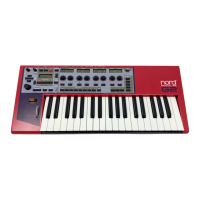NORD MODULAR G2 V1.1 5. Basic functions: Modulation
Page 33
considerably less than 0.5 (leaving less than half of the level of the incoming signal to modulate). A setting
of 0 shuts off the modulation completely. The pitch mod-input on the various oscillators and the ‘dB’
attenuation alternative in the Mixer modules are examples of Type II attenuation.
[T
[T[T
[T
Y
YY
YP
PP
PE
EE
E
III]
III] III]
III]
The mod-amount knob affects the incoming signal in an attenuated and amplified, linear fashion. A set-
ting of 200% (maximum) amplifies the incoming signal to twice its original level, a setting of 50 leaves
the incoming signal unaffected and a setting of 25 attenuates the incoming signal by a factor of 0.5 (leav-
ing half of the level of the incoming signal to modulate). A setting of 0 shuts off the modulation com-
pletely. The frequency mod-input on the various filters are the sole examples of Type III attenuation.
M
MM
M
O
OO
OD
DD
DU
UU
UL
LL
LA
AA
AT
TT
TI
II
IO
OO
ON
NN
N
E
EE
EX
XX
XA
AA
AM
MM
MP
PP
PL
LL
LE
EE
ES
SS
S
P
PP
P
U
UU
UL
LL
LS
SS
SE
EE
E
W
WW
WI
II
ID
DD
DT
TT
TH
HH
H
M
MM
MO
OO
OD
DD
DU
UU
UL
LL
LA
AA
AT
TT
TI
II
IO
OO
ON
NN
N
Let us use the pulse width on the OscDual module as an example
in two scenarios:
1. If you want to modulate the pulse width from the minimum value (1%) to the maximum value
(99%) with a positive envelope (that produces a control signal with a peak to peak level swing from 0
units to +64 units), set the initial pulse width (PW) to 50% and the mod-amount to 100.
2. If you want to modulate the pulse width from the minimum value (1%) to the maximum value
(99%) with an LFO (that produces a bipolar control signal with a peak to peak level swing from –64
units to +64 units), set the initial pulse width (PW) to 75% and the mod-amount to 50.
Increasing the setting of the mod-amount can force the pulse-width beyond the limits (1% – 99%).
This will result in the signal being “mirrored”.
Note the difference between the total amount of modulation from an envelope (unipolar, 64 units) and
from an LFO (bipolar, -64 to + 64 units = 128 units). This explains why the first scenario has the mod-
amount set to 100, and the second scenario set to 50 for maximum modulation.
P
PP
P
I
II
IT
TT
TC
CC
CH
HH
H
M
MM
MO
OO
OD
DD
DU
UU
UL
LL
LA
AA
AT
TT
TI
II
IO
OO
ON
NN
N
A signal routed to a Pitch input on a module affects the pitch by
modulating it linearly in the note scale (see figure to the right be-
low)
The figure to the right shows an A4
note being pitch modulated by a sym-
metric bipolar signal.
amplitude
pitch
A4, 440 Hz
A5, 880 Hz
A3, 220 Hz

